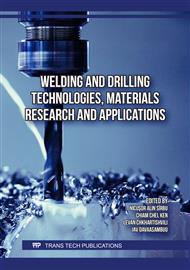p.3
p.17
p.23
p.31
p.41
p.49
p.59
p.73
Integration of Thermographic Data and SolidWorks Simulation for Welding Process Optimization in Shipbuilding
Abstract:
This study investigates the thermal field of S355J2+N steel plates for shipbuilding applications welded with automatic welding equipment. Real-time thermal profiles were captured and validated using infrared thermography against SolidWorks simulations. Experimental data revealed maximum weld pool temperatures of 528 °C and sharp thermal gradients in the heat-affected zone (HAZ). The numerical model, which predicts a peak temperature of 670°C, closely matched the experimental results. An empirical relationship between welding parameters and maximum welding temperature was derived, allowing optimization of heat input and welding speed to minimize thermal distortions and residual stresses. This integrated approach improves process control and weld quality in shipbuilding.
Info:
Periodical:
Pages:
23-30
Citation:
Online since:
November 2025
Price:
Сopyright:
© 2025 Trans Tech Publications Ltd. All Rights Reserved
Share:
Citation:


